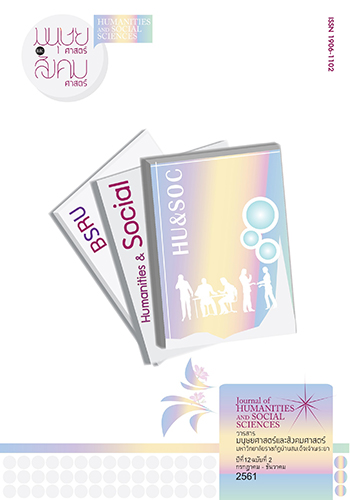The King’s composition on Ramakien Literature of King Thonburi to Dramatic Performance
Keywords:
Literature, Ramakien, King Thonburi, Dramatic PerformancesAbstract
The Ramakien plays by King Thonburi were the most worth literature masterpiece. He did these writings since the beginning of his reign even though there were many wars during his dynasty. However, whenever he had free time, he would consult and gather data of the Ramakien plays since Ayuthaya period by his writings. There were 4 episodes: The 1st episode was Phra Mongkuth in his maneuver of the arrow and Phra Lop came to help him to run away which this episode was in the end of Ramakien, but King Thonburi wrote the 1st play. The 2nd episode was Hanuman courted Nang Wannarin by killing Virunjambang and King Maleewaraja. The 3rd episode was King Maleewaraja conducted a case till Thossakan entered the city, and the last episode was Thossakan took Sayklod rite, Phra Lak got Kabilapath spear till Hanuman held Thossakan and Monthokiri’s hair together. By the stories in episode 2 to 4 continuously, King Thonburi desired to restore royal drama as in the same time as Ayuthaya period which was ruined because of the loss of Ayuthaya to Burma in 2310B.E. The royal drama masters were separated from Ayuthaya by scattering to live in others upcountries. Then, King Thonburi had the royal command to call them back to Thonburi city again for practising royal women drama as in his plays that was the starting of restoring Ramakien plays in royal women drama performances in Thonburi reign until the last of his reign. At the beginning of Rattanakosin reigns, royal women drama performances were also found, but they performed as per each reign’s plays until changed the name of royal women drama and called Lakorn Nai in relation to Lakorn Noke which was played by all men actors and bringing the performance of Ramakien to show, usually performed in Khon performance. For Lakorn Nai, it was a popular play in I-Nao and Unnaruth only, hence, there were bringing Ramakien plays by King Thonburi to perform more often too. The study found that the Ramakien plays by King Thonburi had the unique identity of being the plays as unrhymed Thai verse as singing in drama, the type of play was no need to have internal and external rhymes between any sentences or long vowels. It can be harmonous with short vowels and the song would emphasize Na Path song, together with the continuity of story was different from others plays. Besides, these performances of King Thonburi plays were shown by all women who were the most beautiful and had many skillful performers in Thai Classical Dance. The costumes were correct according to the tradition of performances with the music by Pli Path of gentleness wooden and performed like the royal plays.
References
กรมศิลปากร. (2549). บทอัดสำเนาการแสดงโขนเรื่องรามเกียรติ์ตอนหอกกบิลพัสดุ์.
กรมศิลปากร. (2532). วรรณกรรมสมัยธนบุรี เล่ม 1. กรุงเทพฯ : อมรินทร์.
ดำรงราชานุภาพ, สมเด็จพระเจ้าบรมวงศ์เธอ กรมพระยา. (2546). ละครฟ้อนรำ. กรุงเทพฯ : มติชน.
ไพโรจน์ ทองคำสุก. (2560). บทอัดสำเนาการแสดงโขนเรื่องรามเกียรติ์ตอนหนุมานรบวิรุญจำบัง.
สำนักงานคณะกรรมการวัฒนธรรมแห่งชาติ. (2534). นิทรรศการพิเศษรามเกียรติ์ในศิลปะและวัฒนธรรมไทย (เนื่องในวโรกาสที่สมเด็จพระเทพรัตนราชสุดาฯสยามบรมราชกุมารี ทรงมีพระชนมายุครบ 3 รอบ). กรุงเทพฯ : อมรินทร์.
เสาวณิต วิงวอน. (2555). วรรณคดีการแสดง. กรุงเทพฯ : ศักดิโสภา.
Downloads
Published
How to Cite
Issue
Section
License

This work is licensed under a Creative Commons Attribution-NonCommercial-NoDerivatives 4.0 International License.




